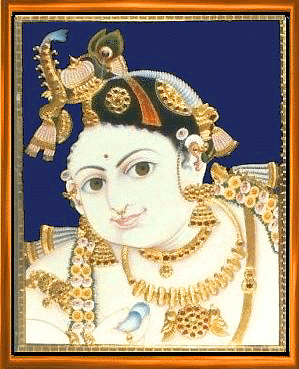Tanjore Painting: Devotional Art of South India
BY: SUN STAFF

Jun 03, CANADA (SUN) — Thanjavur is also known by its anglicised name, Tanjore. The city and municipality is located in Thanjavur district in the state of Tamil Nadu, about 10 km south of the Kaveri River. It was the royal city of the Cholas, Nayaks and Mahrattas, and reached it pinnacle during the era of Rajaraja Cholan. Thanjavur gets its name from Tanjan, an asura who caused a great disturbance in the area and was eventually killed. With his last breath, the demon asked that the place of his death be named after him. Today, Thanjuavur is known as the "rice bowl of Tamil Nadu". It is famous for many things, including the thousand year old Brahadeeswarar Temple and the exquisite devotional paintings produced by local artists.
Tanjore painting is one of the finest forms of classical painting in South Indian. The earliest works of Tanjore art date back to about 1,600 CE, when the Nayakas of Tanjavur encouraged not only painting, but also classical dance, music and literature. The sacred literature of the day was written in both Telugu and Tamil.

Tanjore paintings are loved for the richness of their surface, the vivid colours and clean compositions. Typically embellished with precious metals and gemstones, these paintings often serve as devotional icons. Among the most popular images are those of Sri Sri Radha Krsna, Navaneet (butter pot) Krsna, Laksmi devi, Ganesh, and other demigods and saints. The transcendental figures in Tanjore paintings are readily identified by their large, rounded faces are wide-open eyes.
Paintings typically feature a prominent main personality, centrally placed, with smaller figures to the side and rich ornamentation framing the figures. Most Tanjore's are panel paintings, being painted on solid wood planks rather than canvases, so they're known locally as 'palagai padam' (palagai - wooden plank; padam - picture).
Tanjore Painting Technique
Many technical steps are required in the making of a Tanjore painting. A wooden base is chosen, of a thickness that will not warp. To this is affixed a thick layer of cardboard, on which is pasted a white, unbleached cloth known as kora. A paste is then made of chalk powder or zinc oxide mixed with a water-soluble adhesive, which is then applied onto the base. To make the base smoother, the surface is lightly sanded. Next, a preliminary sketch is made on the prepared surface. Using a paste of chalk powder and gum arabica ahesive, called gessore work, a three-dimensional effect is built up from the flat sketch.

Navaneet Krishna
Tanjore, c. 1860
The piece is then embellished with pearls and other semi-precious stones, also known as 'Jaipur stones', which are set into the gessore forms. The stones, etc. are typically applied to garlands, jewellery, head pieces and surrounding architecture in the scene. Laces or threads may also used as decoration. 24K gold foils are then lavishly applied to the piece, being secured with a paste mixture. Finally, dyes are used to add color and richness to the figures in the paintings. The painting is done with poster colors, in traditional shades including red, green, yellow, black, brown, and rust. The areas where gold foil was applied are also outlined in black, to add further depth to the painting. Finally, the piece may be set in a richly ornamented frame, often decorated with a mango motif or similar geometric shape which adds to the opulence of the piece.
